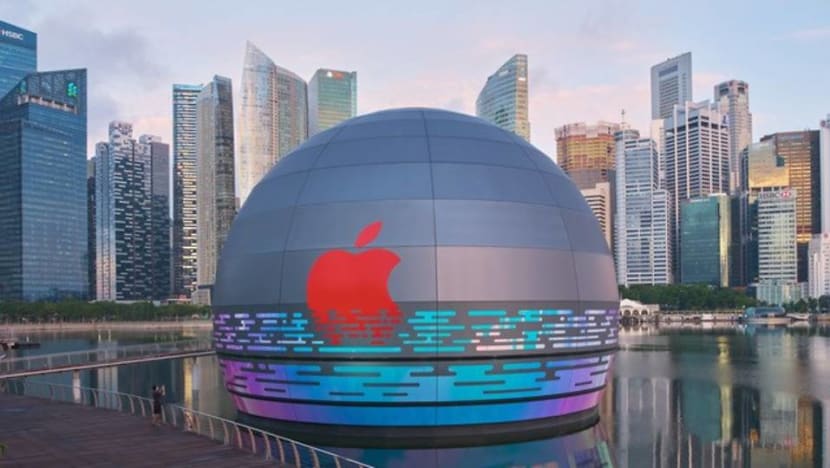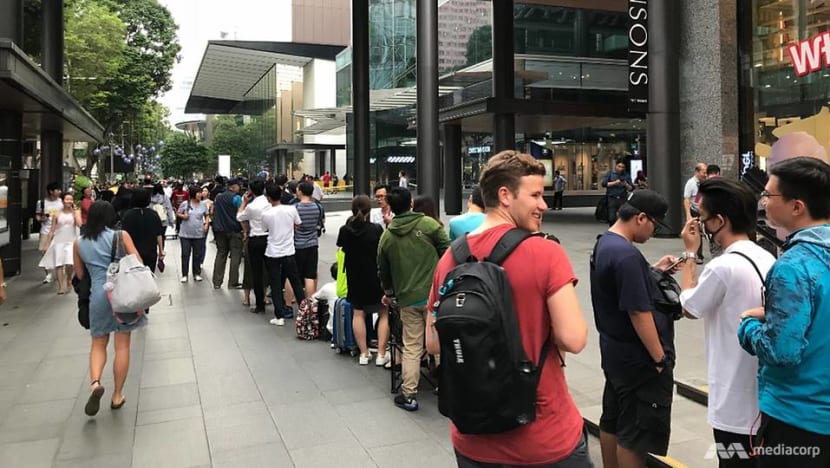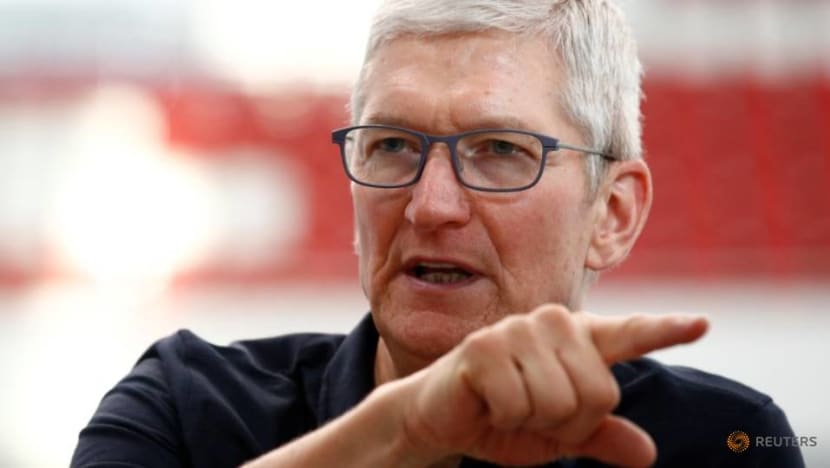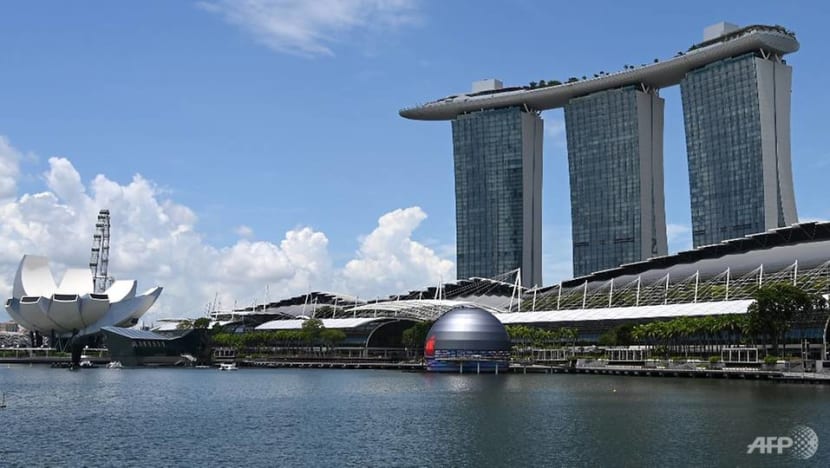commentary Commentary
Commentary: Does tiny Singapore really need a third Apple store?
Are Singaporeans so obsessed with Apple that a third store seems justified? SUSS’ Vanessa Liu and Lau Kong Cheen discuss what may be Apple’s calculations.

Apple Marina Bay Sands is coming to Singapore soon. (Photo: Apple)
SINGAPORE: The first Apple store in the world that sits on the water will be opening soon at the Marina Bay Sands.
This will be the third Apple store in Singapore, following the two in Orchard and Jewel Changi Airport that opened doors respectively in 2017 and 2019.
But with a population of 5.7 million, is there sufficient demand for Apple products in Singapore? Why is there a need for a third store?
LISTEN: Recovery, restructuring and possibly rebound? The outlook for the Singapore economy
NOT UNUSUAL
To be sure, Singapore is not the first city where Apple has rolled out new stores aggressively.
The tech behemoth seems to have adopted a similar market development strategy in another familiar Asian metropolitan – Hong Kong. In fact, Apple opened three stores in Hong Kong within the first 12 months of hitting the Causeway Bay shores in 2011.
Despite its smartphone market share plunging from 60 per cent in 2011 to about 40 per cent in 2016 in the city, owing to Samsung launching two of its best-selling phones, the Galaxy S III and the Galaxy S4, two more new Apple stores were established in that same year, leading to a total of six physical outlets in a city of 7 million.
READ: Commentary: The iPhone 11 and Apple’s most ambitious play ever
READ: Commentary: With iPhone 11, Apple is playing catch-up
In this context, having three Apple stores in Singapore doesn’t seem out of the norm. In fact, the question might be why not more?
SINGAPORE’S MARKET POTENTIAL
Apple “could use a third store” in Singapore given the Orchard Road one seemed “pretty full”, CEO Tim Cook had expressed in a visit to the city last December.
This is very true. With only one downtown, customers often have to suffer long waits and snaking queues, particularly given COVID-19 restrictions on crowd sizes.
Seeing also that the new outlet in Jewel helps little given its distance from the city centre, a third store does look like a practical solution to sustain service quality and customer satisfaction.

Yet it isn’t quite like Apple for resolving capacity issues to be the main driver of such strategic moves.
Apple clearly sees more in Singapore. In assessing its market potential, Apple may be looking at catering to regional demand.
As a transit hub for tourists, Singapore has good potential to reach a much larger market. In fact, Singapore is one of two cities in Southeast Asia in which Apple has a physical presence, with Bangkok being the other.
Known to be big fans of iPhones and big overseas shoppers, Chinese tourists may be another major source of revenue Apple has its eye on in deciding where to locate its next store.
READ: Commentary: Underwhelming AirPods Pro? Here’s why Apple users remain incredibly loyal
READ: Commentary: Will COVID-19 spell the end of strata malls?
Among the top 10 destinations of this group, Apple stores can only be found in three other places – Hong Kong, Japan and Thailand.
Singapore too received 46 per cent more Chinese tourists in July last year, according to the Singapore Tourism Board.
THE US-CHINA TRADE WAR
Geopolitics too may have played a role in this story.
Plans for the third Apple Store were rumoured to have been conceived early last year, following the arrest of Huawei Chief Financial Officer Meng Wanzhou in Canada in end-2018.
We wouldn’t rule out Apple preparing for the risks brought about by the US-China trade war.
Since mid-2019, Apple has begun exploring a relocation of production facilities out of China to Southeast Asia or even back to the United States.

The tech giant was said to have requested for AirPods suppliers to consider moving up to 30 per cent of hardware production away from China. Partner manufacturers that make iPhone parts have also explored new factory options in Vietnam, India and Taiwan.
And it’s not only supply chains and production centres potentially shifting out in a China+1 strategy.
We wouldn’t rule out changes to front-facing stores, as the 10-year lease of Hong Kong’s flagship store expires next year, which could provide renewed impetus for Apple to re-evaluate its business strategy in Asia after the city has seen a year of tumultuous protests.
Hong Kong is losing its friendly and vibrant retail environment. Frequent hostile street protests and stronger government intervention have aggravated this.
READ: Commentary: In Hong Kong, the COVID-19 outbreak sent shockwaves but could reinvigorate protests
READ: Commentary: How did Hong Kong get to a third wave of COVID-19 infections?
The number of mainland Chinese visitors in Hong Kong dropped by over 58 per cent in the last quarter of 2019 prior to the pandemic outbreak. There will be a glut for Apple products in Hong Kong if China fans avoid the city.
Apple knows it must develop other geopolitically friendly and neutral market destinations, with this Marina Bay Sands store in Singapore possibly the first of many such steps.
A SHRINE TO THE BRAND
From a branding perspective, adding another iconic flagship store makes good business, where having a strategic, highly visible presence helps sustains Apple’s iconic status.
Apple is a brilliant marketer. Stores are more than just a location for customers to purchase iPhones, Apple watches, Macs, and other Apple accessories. Apple’s Fifth Avenue store in New York City is, after all, one of the most photographed places in the city.

Such a seminal flagship store acts almost like a shrine which fans make pilgrimages to as they practise rituals of queueing for new Apple product launches.
These are places where likeminded fan boys and fan girls can gather, often under Apple’s new signature in-store foliage, check out new products and revel in the brand they love.
These gathering points feed a cult-like culture behind the brand, with the new floating Apple store looking incredibly impressive part of that strategy to reinvent brick-and-mortar shops for a superb consumer experience in a digital age.
Apple stores leverage one-of-a-kind, outstanding architectural design to reinforce the otherworldly environment they want to create for their fans, yet the attention to detail of every cutting-edge store ensures each projects the same, sleek image of the company.
READ: Commentary: iPhone SE is Apple’s cheapest yet but there's more than meets the eye
READ: Commentary: Google Pixel 4a a decent phone but wait a little longer before switching
This clever marketing tactic that instills their brand image and values also gives Apple an edge over its competitors – primarily Samsung and Huawei.
Although these two brands are widely acknowledged to be technologically comparable to Apple, they don’t possess the kind of brand affiliation Apple commands of fans.
An effective strategy to establish long-term relationship with customers is dependent on the ability to provide them with a brand experience that fulfils their emotional and functional needs.
An Apple Store is an effective vehicle to achieve this – as a one-stop location where a customer can fully gear up with a spread of Apple products and accessories, with store assistants au fait with the products who also give consumers sufficient space to explore.
THE BET APPLE IS TAKING ON SINGAPORE
Despite the slowdown in retail and tourism, Apple seems to trust that Singapore will bring back tourists faster than other countries.

Singapore has demonstrated potential for a strong COVID-19 recovery, including the determination of the Government to revive its aviation hub, which plays to Apple’s interest.
The company is betting the Marina Bay store will pique the curiosity of and draw new regional customers, while the Jewel Changi Airport outlet will cater to transit travellers as international travel picks up.
We know Apple plans for the long haul. With Apple’s strong balance sheet and positive revenue outlook, it is an opportune time to open their next iconic flagship store right in Singapore, the beating heart of Asia.
Dr Vanessa Liu and Dr Lau Kong Cheen are senior lecturers, Marketing Programme at the School of Business in the Singapore University of Social Sciences.

















